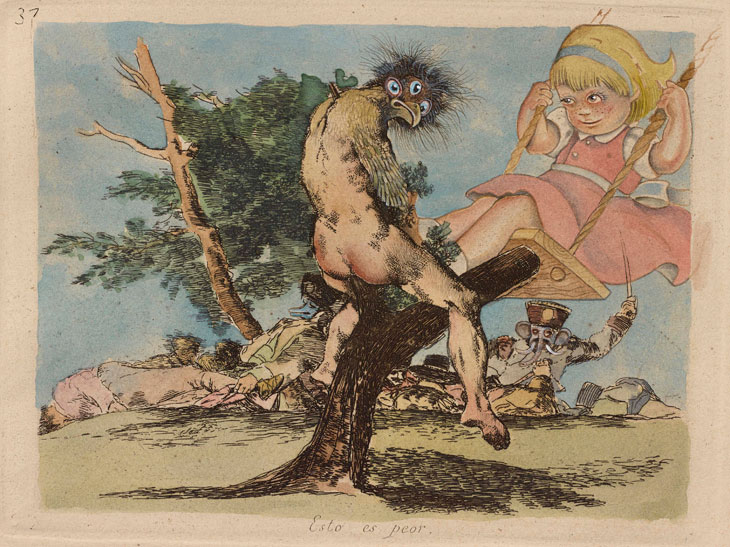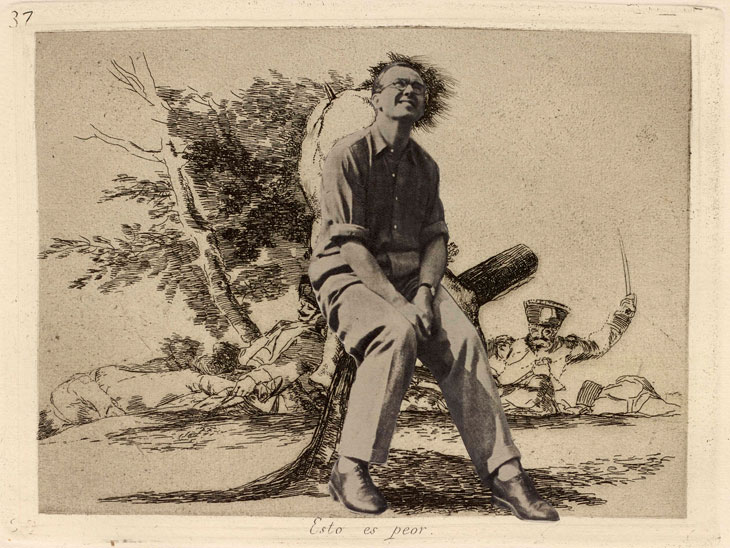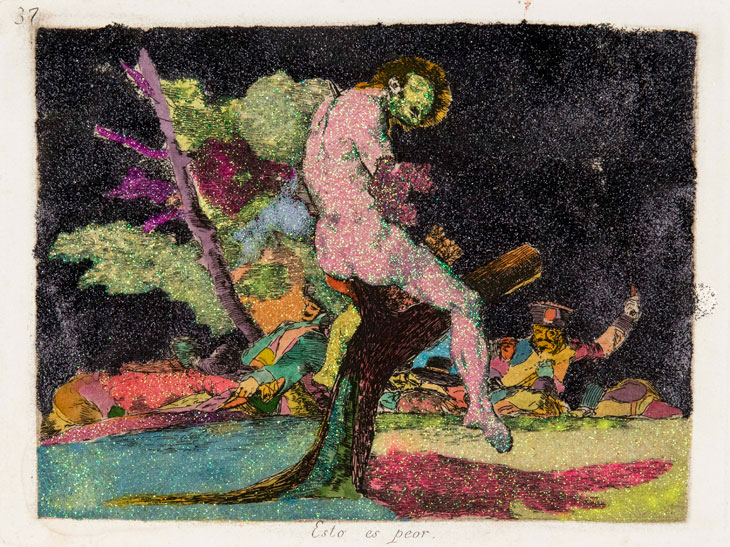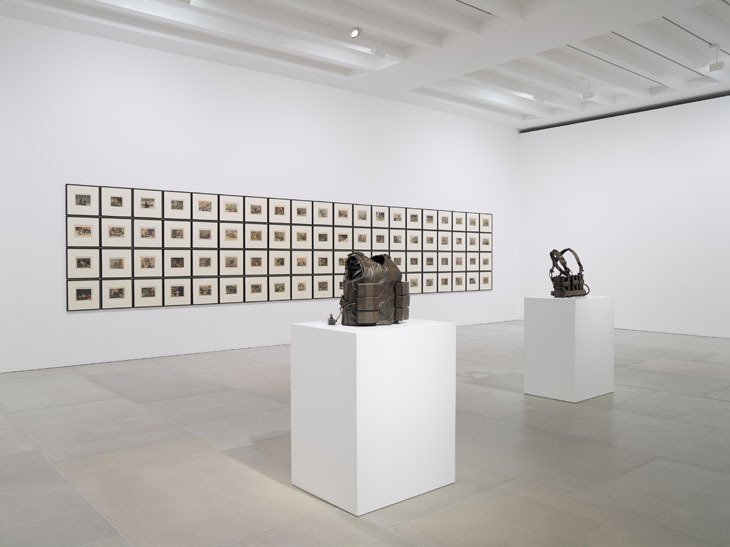In many ways, Jake and Dinos Chapman’s first show for Blain|Southern is about continuity rather than change. They might have left White Cube for pastures new, but ‘The Disasters of Everyday Life’ is very much vintage Chapman brothers: a perpetuation of their seemingly inexhaustible fascination with Goya, along with a set of extraordinary sculptures of suicide vests created with a definite eye to shock value as well as aesthetics. But beneath any initial sense of two artists working squarely in their comfort zone (if that phrase could ever be applied to the Chapmans) is that of two artists at the top of their game. As the Chapmans’ exhibitions often are, ‘The Disasters of Everyday Life’, contrives to be repetitious and original, juvenile and profound, chastening and laugh-out-loud funny. It is superb.
Though the press may focus their attention elsewhere, the bulk of the exhibition is taken up with a return to the work referred to in its title: Goya’s Disasters of War. The Chapmans have been busily ‘reworking and improving’ Goya’s etchings since the Insult to Injury series of 2003, but at this point they show no signs of either slowing down or running out of ideas. It could well be the defining project of their career – a Weirdo-World counterpart to Tom Phillips’ A Humument. Here, there are no fewer than three complete sets of the Disasters on display, each reworked with different materials according to a different aesthetic.
The Disasters of War on Terror (2017), Jake and Dinos Chapman. Courtesy the artists and Blain|Southern. Photo: Prudence Cuming

The works in the first set are both crowded and delicate. First, Goya’s grounds are carefully worked over with watercolour in the manner of old hand-tinted etchings, then the trademark grotesque animal heads and horror-prosthetics first seen in Insult to Injury enter. This time, though, there is the fresh addition of a whole cast of onlookers, inserted into the backgrounds of the prints. The new witnesses for the horrors of war are lifted in style from children’s books of the 1940s and ’50s: an ensemble of teddy-bears in clothes and uniforms, kittens with bows, children; all with expressions ranging from shocked surprise to sadistic pleasure. In the execution scene of Bárbaros!, the victim tied to the tree, face toward the trunk, has the back of his head turned into a single eye, addressing the firing squad dolefully; behind them all, a giant teddy looks on, open-mouthed.
By now the joke of children’s illustrations turned dark is an old one – the onlookers could have been lifted from Deryk Thomas’ paintings and cover art for Swans and Angels of Light albums, or, for that matter, South Park’s foul-mouthed and psychotic ‘Woodland Critters’ – but it works sublimely here. As elsewhere in the series, Goya’s terse, ironic, condemnatory captions, seem to be ventriloquised into the mouths of the cuddly toys – at times aghast, at times demonically satisfied and turning any irony inside out with their pleasure. It is still funny, but of course it is not funny at all – like Goya himself.
The other two sets are, if anything, even dafter. One delights in the sort of puerile hamfistedness you might expect of a teenager defacing textbooks; the other, in the sort of paint-by-numbers mindlessness of adult colouring books marketed as creating ‘mindfulness’, combined with toddler craft projects.
The Disasters of Everyday Life (2017), Jake and Dinos Chapman. Courtesy the artists and Blain|Southern. Photo: Prudence Cuming

The former set takes Goya’s prints as grounds for photo collages, ranging from the carefully integrated, to the plonked-on-top, to form a series of sight gags that had me laughing out loud. In Esto es lo peor!, the Chapmans’ naked toddler reaches out to caress the head of Goya’s animal – is it a wolf scrivener? Elsewhere, pedigree dogs and penguins wander through the scenes of horror, happy and oblivious. A few prints just have images of gallery rail lights pasted over them; a jab at the Enlightenment, suggest the gallery’s director of exhibitions Craig Burnett, which has been viewed with suspicion by Goya and the Chapmans alike. Much of the series turns into a guessing game, spotting the few famous faces among the additions: Jackson Pollock squating in the foreground of Contra el bien general; Hergé sketching away in ¡Duro es el paso!. In the original of Lo mismo, an axe-wielding civilian rears over a hussar who has his hand uselessly raised to defend himself, in the midst of a heap of bodies. In the Chapmans’ version, Metallica’s James Hetfield, mid guitar solo, obscures the centre of the print – one axeman for another.
The final set of prints is both the silliest and the prettiest of the three. Indeed, it is possibly the prettiest thing the Chapmans have ever produced, which is itself a special kind of joke, given the substrate involved. Every plate has been covered in glitter, the details largely disappearing in favour of sparkling blocks of colour. From a distance, the effect is of a sort of glam Gauguin, or craft Kandinsky. Up close, the individual prints are surprisingly delicate – the Chapmans, it turns out, are rather good at glitter. Part of the joy of it is appreciating the brilliance of Goya’s original compositions – when you are not busy scrying for details, it is even clearer how superbly composed the originals are, even when they seem most deliberately off-kilter. The rest of the pleasure lies in the subversion of the horrible to the hilarious: Goya’s hussars become disco pirates; the dismembered corpses of Grande hazaña! Con Muertos! look like they are wearing leotards or yoga leggings.
The Disasters of Yoga (2017), Jake and Dinos Chapman. Courtesy the artists and Blain|Southern. Photo: Scott Massey

The final section of the show – and perhaps the main event – is the set of new sculptures titled Life and Death Vests: nine bronze casts of suicide-bomb vests, presented like classical torsos on plinths. It is, without a doubt, a contentious source of subject matter; but that is hardly surprising for the Chapmans. And they are chilling and beautiful pieces, richly strange to study in the gallery. They may well be criticised for aestheticising terrorism, but the Chapmans have to some extent pre-empted that already. The first piece in the series, Burnett explained to me, is cast directly from a prop suicide vest worn by Jackie Chan in Rush Hour – go online, and you can even find the prop auction site from which the Chapmans acquired it. It is an action-comedy prop, brought over into the gallery as a bronze monument, and it acts as a sort of tidal defence against the idea that the brothers are cutting too close to the bone here. After all, if it is permissible for Hollywood to make fake bombs, why shouldn’t the Chapmans? That the defence does not quite hold up only helps: the critique cuts both ways. And, based as it is on a scuba-diver’s buoyancy aid, it gives the series its paradoxical title too.
Cut through any initial shock, and the Life and Death Vests rank with the best sculptures in the Chapmans’ canon. The casting is superb: every detail of the canvas straps and webbing is preserved, giving the strange material pleasure of seeing a suicide bomb as a piece of tailoring and craft. They are somehow inescapably domestic – who has not worn a backpack, and pulled on the canvas straps to fit it better? – and terrifying. And the hollow space at the centre of each one preserves the absence of a bomber who is an object of both fear and pity.
‘The Disasters of Everyday Life’, installation view at Blain|Southern, 2017. Courtesy of Jake and Dinos Chapman and Blain|Southern. Photo: Peter Mallet

The Chapmans’ central gift is combining the puerile and the dangerous, but the Life and Death Vests manage to add profundity to the mix too. I suspect they might shrug that last one off as precisely the wrong kind of compliment, but these sculptures are profound. There are not many artists who could triangulate Jackie Chan, terrorism, and classical sculpture, and leave the viewer feeling as if all three are uncomfortably close to their everyday experience. And that is the point here: the fanciful idea that war is a matter of military on military, which has been promoted with the professional armies of the 20th and 21st centuries, was anathema to Goya, and should be anathema now. Terrorism as an offshoot of modern conflict is precisely about creating disasters within and out of everyday life – in these sculptures, a rucksack, an old Nokia mobile phone; in real life, the improvised bricolage of bomb-making that can put a Lidl bag and a bucket at the centre of an attempted atrocity – which is precisely what this show brings to the fore in its title.
All of this would not count for much if the Life and Death Vests were not so striking on an aesthetic level: they are beautiful objects, not far from engendering the kind of reverie a neo-classicist might experience before a Greek sculpture. Which, I suspect, is the whole idea, and another point of reference. When Rilke looked at the ‘Archaic Torso of Apollo’ in the Louvre, he gloried in the sense it gave him that it ‘burst from all the borders of itself / Like a star’. These torsos threaten to do the same, only with a particularly blunt literalism: not luminous gods on pedestals bursting with internal light, but real people walking in the streets, ready to destroy themselves and those around them. I could not escape the sense Rilke’s torso was hovering in the background of the Life and Death Vests, still saying, as it did to him, ‘You must change your life’, but with an altogether different tone of voice, and an altogether different meaning.
‘Jake & Dinos Chapman: The Disasters of Everyday Life’ is at Blain|Southern, London, from 4 October–11 November.



